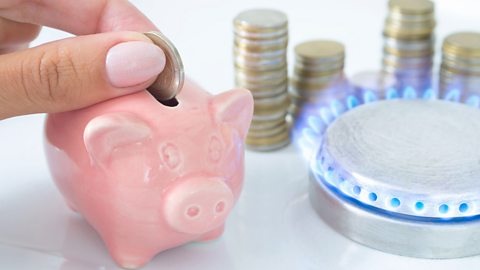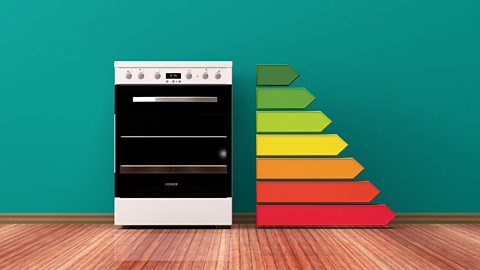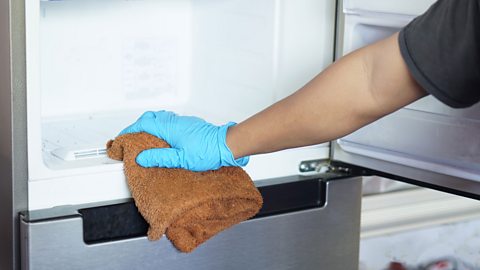How much could you save by not using your oven?
By Sue Quinn
Energy prices are soaring across the UK and many of us are looking for ways to reduce our bills. Can changing the way we cook - like finding an alternative to using the oven, help?

The cost of cooking involves more than just the price of the ingredients. Hobs, ovens, refrigerators, and kettles are just a few of the appliances that make cooking and storing food and drink possible, and all of them consume energy. In fact, around 20% of an average household’s energy bill is consumed in the kitchen, according to the Energy Saving Trust.
But scientists say there are many ways to bring these costs down. They vary from household to household, depending on the amount of food you’re cooking, the appliances you have and your lifestyle. But the savings can be significant. “The average British household could save about £5 a week by making a few small changes,” says Dr Christian Reynolds, Senior Lecturer at the Centre for Food Policy at City University, London.
Stop using your oven

“Ovens are particularly inefficient because you have to heat up a big metal box as well as your food,” says Sarah Bridle, Professor of Food, Climate and Society at York University and author of Food and Climate Change Without the Hot Air. “Your oven might not be well insulated, so you end up heating the whole kitchen, too. Using the oven only on special occasions is the single most impactful thing an individual can do.”
Microwaves, slow cookers, electric pressure cookers and air fryers all consume significantly less energy than ovens, so using these instead, if possible, will save you money. “Microwaves are particularly energy efficient,” Dr Reynolds says.
However, while microwaves are useful for things like defrosting and reheating food and drink, and cooking vegetables, they’re not suitable for everything. A joint of meat or roast chicken for example, is much tastier and more tender cooked in a slow-cooker or pressure cooker.
“Slow cookers are equivalent in energy use to a microwave and draw about the same energy as an electric light bulb,” Dr Reynolds says. “Electric pressure cookers are also amazing because they considerably shorten the cooking time.” Both are also ideal for cooking curries, stews and soups, which need long slow cooking.
Slow cooker recipes have the advantage of being made ahead, and are ready the minute you walk in the door. With pressure cookers, dried beans or tough cuts of meat like brisket are soft and tender in under an hour.
The situation isn’t clear-cut, though. Microwaves and air fryers can’t accommodate as much food as an oven, so you may need to run them more than once to cook the amount you need, reducing your savings. And delicate baked goods like cakes, bread, and biscuits are much better suited to an oven.
If you do use the oven, try turning it off 5–10 minutes before the end of the cooking time specified in the recipe; the food will finish in the residual heat. This technique isn’t suitable for cakes, bread, and biscuits, which require precision cooking. But it works well with dishes such as casseroles, pies, roasted vegetables, shepherd’s pie, and lasagne.
“Also, if you do use the oven a lot, consider whether this could help you reduce your heating bills by reducing the thermostat and spending more time in the kitchen and less time in other colder rooms,” Prof. Bridle suggests.
Related stories
Think about how to get the most from your appliances
Using a combination of appliances to reduce the time your oven is on can save you money without affecting the quality of your finished dish. Vegetables (especially whole potatoes in their skins) can be par-cooked in the microwave and then transferred to the oven or air fryer, or placed under the grill, to finish and crisp up. Browning meat or chicken in a pan on the hob before transferring to a slow cooker or pressure cooker imparts a roasted flavour.
Filling your oven, not just roasting, or baking a single item, makes maximum use of the energy it consumes, so cook in bulk to save money. Portions you don’t eat straightaway can be chilled or frozen, and reheated in the microwave. If you bake potatoes in their skins in bulk, jab them with a fork and rub generously with salt so their skins go hard. This means their skins will still be crisp when you reheat them in the microwave. If you make your own bread, always bake more than one loaf at a time. Dr Reynolds suggests boiling enough water for several cups of tea, then transferring what you don’t use straightaway to a vacuum flask to keep hot for later. This avoids repeatedly turning on the kettle.
Prof. Bridle suggests switching to food that doesn’t require cooking. Eating bread instead of toast, and soaking oats overnight in the fridge in milk, water, or fruit juice instead of cooking up a batch of porridge, can also reduce your bills. (However, cooking porridge in the microwave uses minimal energy, she adds.)
Put the lid on

Cooking in a pan with the lid on traps the heat, which means food cooks more quickly, or without having the hob turned up so high. This uses 30% less energy than cooking in an uncovered pan, according to Dr Reynolds. “Always choose the right size pan for what you’re cooking,” he adds. “Filling up a 20-litre pan to cook pasta for one person is a waste of money.”
Again, there are exceptions to the rule. Generally, the cheapest way to boil water is in a modern (energy efficient) electric kettle, making sure you heat no more than the amount you need. The Energy Saving Trust recommends boiling water to cook pasta or vegetables in an electric kettle first, then pouring it into a pan. This approach could save you £6 a year on your energy bills, it says.
This may not be the case if you have an induction hob, which is the most energy efficient hob for cooking. Induction hobs waste less energy than standard electric stoves, so food and drink heats much more quickly. If you have an induction hob, the cheapest way to boil water for tea could be a kettle on the hob, and for cooking, in a covered pan. But this can vary according to your induction hob and the pans you’re using.
Use appliances wisely

According to the Energy Saving Trust’s Joanna O’Loan, fridge-freezers account for 12% of household energy bills. “They’re continually drawing power to maintain a constant temperature,” she explains. To ensure yours has the best chance of doing its job efficiently, she recommends:
- Letting food cool down thoroughly before transferring to the fridge, or it will have to work harder to maintain the set temperature.
- Defrost food in the fridge, as this will help to keep the temperature of the air inside it down.
- Never leave the fridge door open unnecessarily.
- Keep the temperature between 3 – 5 degrees Celsius. To check the temperature, leave a thermometer in a glass of water on the middle shelf for 12 hours or overnight.
- Defrost your fridge and freezer regularly, as it has to work harder when covered in ice.
Dishwashers are energy-hungry, too, because they have to heat water needed as well as run the cleaning mechanism. “You could save £14 on your annual energy bills reducing use by one run per week,” O’Loan says. Ideally wait until the dishwasher is full before running a load, she says. Even though might take longer, always use the eco setting. According to consumer group Which? this uses 30% less energy and water compared to the main programme.
New appliances
If you need to replace an appliance, look at the energy label and choose the best rated model that meets your budget and other requirements. “Induction hobs are typically the most energy efficient, as no energy is wasted heating space around the pan,” O’Loan says. Gas is cheaper than electricity, so gas hobs typically have the lowest running costs, but they can compromise air quality which could have negative impacts for those in the kitchen – especially if you have a respiratory illness/condition.
If you don’t already have one and your budget allows, a slow cooker can be a worthwhile investment, Dr Reynolds says. Prices start at around £20, and if you regularly use it instead of your oven, you could cover the cost of buying it comparatively quickly. “But I’m not suggesting everyone needs to rush out and buy new appliances,” he says. “Energy saving has to fit in with people's lives.”
Approximate energy consumption of different cooking methods
Figures from Sarah Bridle, Professor of Food, Climate and Society at the University of York, based on Wattage numbers from Supplementary Data of supplementary table of Frankowska et al Nature Food.
Baked potato
- Cooking one baked potato in the oven (120 minutes) = 6.07kWh (assume oven on for 2h including warmup time)
- Cooking one baked potato in the microwave (10 minutes) = 0.14 kWh
- Cooking one baked potato part microwave (5 minutes) part oven (30 minutes cooking plus 15 minutes warmup) = 2.34kWh
- Cooking four baked potatoes in the oven (120 minutes) = 1.52kW (per potato, assume oven on for 2h including warmup time)
Boiling water
- Boiling water for one cup of tea in electric kettle (2 minutes) = 0.07kWh
- Boiling water for one cup of tea in pan on standard electric hob (5 minutes) = 0.18kWh
- Boiling water for one cup of tea in microwave (4 minutes) = 0.05kWh
- Boiling water for one cup of tea in kettle or covered pan on induction hob (2 minutes) = 0.14kWh
Reheating casserole
- Reheating stew on standard electric hob (12 minutes) = 0.43kWh
- Reheating stew in the oven (45 minutes) = 2.27kWh
- Reheating stew in microwave (8 minutes) = 0.11kWh
- Reheating stew on induction hob (5 minutes) = 0.35 kWh
Porridge
- Cooking in microwave (5 minutes) = 0.07kWh
- Cooking on standard electric hob (10 minutes) = 0.36kWh
- Cooking on induction hob (5 minutes) = 0.35 kWh
Originally published March 2022